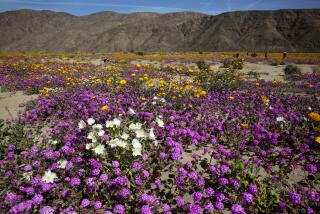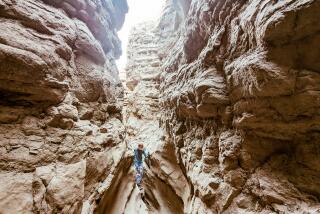Search for Condor Leads to Discovery of PeruŌĆÖs Other Natural Beauties
AREQUIPA, Peru ŌĆö We hoped eventually to get a glimpse of one of the more than 1,000 condors flying over the high Andes in Peru.
At daybreak we boarded a bus and left from here, the second-largest city in Peru, driving about 100 miles north to the condorsŌĆÖ home in Colca Canyon.
After the White City and her green valley became a distant spot, the snowcapped Andean mountain peaks appeared glistening under the morning sun.
Majestic views unfolded one after another in front of our eyes in an endless panorama bordering the Colca River.
The Colca River has carved a great canyon, deeper than Grand Colorado Canyon in the United States. Hot springs with mineral and sparkling waters jump from the cracks of the canyon like a big Jacuzzi.
Traveling along the canyon brings on endless surprises, as the bus begins its climb to 11,100 feet. But the beauty is so spectacular that one forgets about getting sick in the high altitude.
When the canyon widens and the road continues over the plains, llamas, vicunas and alpacas dot the meadow and ignore our presence. The flat golden terraces in the upper part of the ravine form undulated patterns. Peaceful farming fields are scattered on bucolic terraces on both sides of the river.
During colonial times small villages were built at various places along the canyon. Colonial churches stand as testimony to the determination of the Spanish missionaries who tried to establish a Camino Real between Cuzco and Lima.
For unknown reasons, the missions were abandoned.
Because villages were sparsely populated, outsiders knew only of two missions until about 20 years ago, when historian Luis Enrique Tord, following the path of two American explorers, Robert Shippe and George R. Johnson, documented not two but 16 colonial churches in the Colca Valley.
According to Tord the churches were built by the native Collaguas based on blueprints provided by the Franciscans. Now their bells are silent but their altars are still decorated with the works of religious art carved and painted by native artisans.
They display a vision of mestizo art jealously preserved by the locals. When villagers celebrate their festivals, the images of the patron saints are brought out from their churches to lead the procession.
People disguised as Inti, the sun god of the Incas, join them, dancing and singing in their native Aymara. These colorful events take place between April and July.
The few people we saw walking the fields, tending their flocks, were dressed in colorful costumes. The women walked quickly carrying children on their backs, their hands busy spinning wool.
Colca Canyon is 248 miles long. It descends from 14,760 feet over a distance of about 280 miles. The river bed lies between the canyon walls below at 4,526 feet.
The terrain of Colca Canyon kept changing. At 16,400 feet we saw natural formations resembling man-made buildings. These phantasmagoric structures were as amazing as the caves in which were found the remains of Stone Age people.
I climbed 300 feet to one cave. The view of the valley was worth the effort. Centuries ago those caves were used for food storage, corn and quinoa, a protein-rich Andean grain.
A few miles along the road I came upon a stone forest of boulders engraved with petroglyphics, which are often found at high and hard to reach places. Archeologists have tried to decipher them and concluded that they are related to the condor, a presence feared or perhaps worshiped by the Collaguas, who have inhabited the Colca Valley since pre-Columbian times.
As we continued our trip other rocky formations of volcanic origin appeared. An odd group of cone-shaped, tall boulders looked like an army of wandering giants frozen in time.
Their bizarre forms have been polished by the wind during thousand of years. Like most of the canyon, they seemed to be a challenge for mountain climbers.
We arrived at the tourist lodge deep in the canyon late in the afternoon. After a nightŌĆÖs rest we left early to visit the Cross of the Condor, a lookout point from which one often sees the legendary condor.
From where I was standing the town at the other side of the river looked like an abandoned Nativity scene. Brown cubes of dust outlined the isolated settlement by the almost forgotten mission trail.
At the edge of the precipice was an assortment of yellow, red and orange cacti flowers. Try to steal one and the thorns that protect their fragile beauty will close in, piercing an intruderŌĆÖs hands.
Over the tops of the mountains, almost amid the pink clouds of the horizon, we could see the Mismi, one of the 200 volcanoes in the area, and the river from which the Amazonas flows.
The air was crisp, thin. Royal-blue draperies of sky moved away as a veil of soft pink turning cerulean blue painted the background for Colca Canyon.
A dark speck appeared above. The dot became a line moving. Slowly, the bird flew, using the air currents, gliding amid the changing blues, its wings spread in perfection.
It may have been searching for food or may just have been displaying its presence.
The soaring shape was a delight to the eye and raised our spirits. We watched speechless, studying the condor high above.
Although some people find the condor unappealing, these Andean birds with a wingspan of 10 feet or more and weighing up to 25 pounds, making them the worldŌĆÖs heaviest birds, are quite impressive.
They have beautiful masses of white, fluffy feathers draped around their necks that contrast sharply with their black and gray bodies. Andean male birds also have a caruncle, or fleshy comb, on their heads that distinguishes them from the females.
Before the Spaniards arrived in Peru the condor was revered and feared, one historian wrote. Its presence was felt as a moving shadow over the land and people knew that the birds were after food.
ŌĆ£When the conqueror marched through the mountains, the condor, sailing high above the clouds, followed with doleful cries in the track of the army, as if guided by instinct in the path of blood and carnage.ŌĆØ
Colca Canyon is a national sanctuary for the conservation and protection of the condors.
It can be reached from Arequipa by a partially paved road. A one-hour flight connects Arequipa with Lima. On comfortable buses, tourists are provided box lunches, bottled water and oxygen tanks.
In Colca Canyon, lodging is Spartan, but clean.
Travel information can be obtained from the local representative of Foptur Peru (PeruŌĆÖs Tourist Fund), Aero Peru or Faucett Airlines.
In Arequipa, Agencia de Viajes y Turismo Transcontinental Arequipa, S.A., Santa Catalina 213, serves the Colca Canyon.
For more information on travel to Peru, contact the Peru Tourist Office, 999 S. Bayshore Drive, Suite 201, Miami, Fla. 33131, (305) 374-0023.
More to Read
Sign up for Essential California
The most important California stories and recommendations in your inbox every morning.
You may occasionally receive promotional content from the Los Angeles Times.










